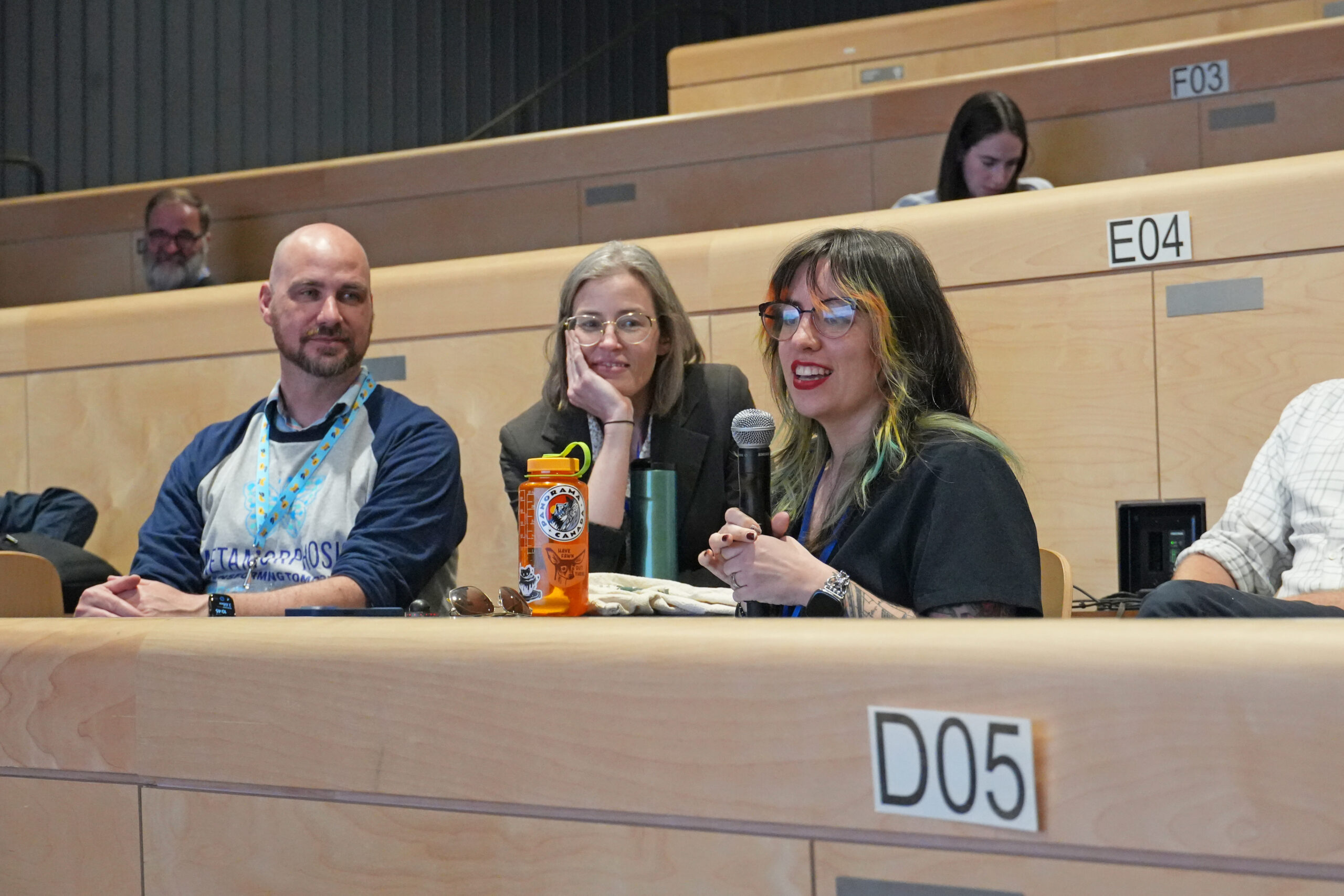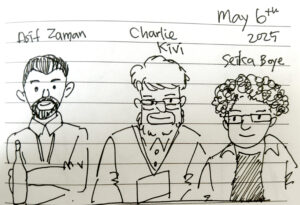
Spring has arrived, and with it, conference season is back! The ETO team has attended (and some of us volunteered at!) several really inspiring conferences this year, including:
- TLS2025: Teaching and Learning for Human Flourishing
- IT Conference @ UofT 2025
- A&S Teaching & Learning Showcase 2024-25
- Google I/O
A huge thanks to all the organizers — your hard work makes these gatherings possible!
Key points we'll take with us
ETO staff members each shared memorable moments from the conferences below. Expand the accordion items to see our key takeaways.
Session Information: Hope Circuits at a time of Seismic Change: Re-wiring our classrooms and institution for Human and Ecological Flourishing | Dr. Jessica Riddell
(from the Teaching and Learning Symposium)
Reflection by: Inga Breede
Session Highlight: I volunteered to facilitate one of the breakout discussions that followed Jessica's presentation. Our group focused on what it means to learn. We discussed some of the different motivations for learning (both from a personal standpoint and what is observed in the classroom) and the challenges of fostering learning and collaboration among students. Finally, we shared ideas on how to improve learning environments.
Key Takeaways: Facilitating the group discussion helped me in two ways: I was able to put the principle of "Yes, and" to practice to encourage open discussion and listened to the challenges and opportunities around fostering learning from my colleagues.

Session Information: Learning Literacy as a Foundation for AI Literacy | Rahul Bhat, Centre for Learning Strategy Support, Resilience Program Lead; Alexander Bowie, Centre for Learning Strategy Support, Learning Strategist, Resilience Focus; Ellyn Kerr, Centre for Learning Strategy Support, Learning Strategist, Grad and Professional Programs; Vivian Zhang, Centre for Learning Strategy Support, Learning Strategist, Innis College
(from the Teaching and Learning Symposium)
Reflection by: Anna Limanni
Session Highlight: One key point that resonated with me from the session was the suggestion that we need to shift from a limiting to a growth model of thinking when considering student use of AI. Rather than approaching AI as purely a threat to academic integrity (where the default assumption is that students will misuse it for cheating and the default stance is to control and limit AI use as much as possible), the presenters encouraged us to see students as capable learners who should be supported in making thoughtful decisions about AI use. This mindset shift moves from fear to curiosity and from policing to facilitation, aligning with a more human-centred approach to learning. The presenters asked everyone to consider the following guiding questions:
- How do we leverage student curiosity about AI?
- How can we support students in using AI ethically?
Key Takeaways: Moving forward, I plan to integrate what I learned into my consultations with faculty. In particular, I want to explore and share the continuum from skill to deskill as a way to help instructors understand that the impact AI can have on student learning is nuanced, rather than all or nothing.
The continuum offers a useful lens for designing assessments and activities that discourage reliance on AI for rote outputs (the deskilling side of the continuum). At the same time, these assessments and activities could promote AI use as a meta-cognitive partner or tutor (the skilling side of the continuum). I also intend to review the resources shared by CLSS, such as the student guidelines on using AI tools, and use them to support faculty in developing strategies that support AI learning literacy in their classrooms.
For more information: Explore the existing resources on AI provided on the CLSS website: Using AI tools for learning at U of T
Reflection by: Allison Van Beek
Session Highlight: “AI can lull students into thinking they are learning.”
Key Takeaways: One key point from this session that jumped out at me was: “AI can lull students into thinking they are learning.”
This resonated because it articulated a concern I’ve found difficult to express—both to myself and to others—about the subtle ways technology can create a false sense of competence. Tools that generate instant answers or polished outputs can feel productive to students, but they often bypass the very struggle that makes learning stick.
Another key takeaway was the distinction between process- and product-oriented approaches: teaching and learning focused on process promotes skill-building, while an emphasis on product risks de-skilling. This framing will be especially helpful as we continue to support instructors in making intentional choices about AI use in their courses—not just what tools are used, but how and why.
This reflection will influence how I frame conversations with faculty about AI tools, how we shape our guidance for instructors, and how we evaluate the learning impact of the technologies we adopt. It reinforces the need to prioritize instructional approaches that centre iteration, reflection, and productive struggle—especially in an era where “getting the answer” is no longer the hard part.
Session Information: Multimedia Assets for Enhanced Student Engagement and Learning | Asif Zaman, Assistant Professor, Teaching Stream, Mathematics; Seika Boye, Associate Director, Undergraduate and Assistant Professor, Teaching Stream, Centre for Drama, Theatre, & Performance Studies; Charlie Kivi, Laboratory Technician and Course Instructor, Chemistry. (Check out Cheryl’s portrait of the speakers below)
(From the Arts & Science Teaching & Learning Showcase)

Reflection by: Cheryl Lee
Session Highlight: The session was a showcase of their projects that they collaborated with the A&S Digital Teaching & Learning Studio. The presenters shared their experience on working with the team to create videos that can be used as supplementary material to their courses. They reflected how much they learned about the production process of the video and how surprising it was to learn that the writing of the script and planning for the video takes the longest, but also shared that as they worked on more videos, they became more effective in writing the scripts and planning the videos out.
Want to learn more?
Check out Professor Asif Zaman’s project Calculus with Fruits on YouTube!
Reflection by: Marisa Curmi
Session Highlight: This session highlighted three educational video projects that were each developed in collaboration with A&S’s Digital Teaching and Learning Studio. The panel discussed how tools like storyboarding and scripting ahead of time make a huge difference, and that working closely with instructors throughout the process helps make the final product more engaging and impactful for students.
Key Takeaways: It was reassuring to see that many of the practices highlighted in the session are already central to how the ETO approaches similar projects. What stood out most was the value of seeing how other teams across campus take on comparable challenges, both to strengthen our own practices and to spark new ideas we can build on.
Session Information: Surviving, adapting and thriving in challenging times: Lessons from history | Heidi Bohaker, Professor, Department of History; LK Bertram, Associate Professor, Department of History; Dr. Donna K. Kidwell, Chief Information Officer
(from the IT@UofT 2025 conference)
Reflection by: Maggie Laidlaw
Session Highlight: In this session, two history professors discussed how lessons from the past can be applied to our current moment of GenAI and growing tensions with the USA. They referenced the Industrial Revolution, active measures, and the rapid modernization of the university during WWI. Drawing from history, they argued we can reduce the harms of past industrial revolutions by protecting workers and the most vulnerable. They also called for younger leadership, Canadian infrastructure, and a willingness to embrace rapid change.
Key Takeaways: Beyond this talk, I’ll continue reflecting on how GenAI adoption echoes the Industrial Revolution and what that means for my own use and guidance on GenAI. I’ll also look to leaders at the University who are learning from History and embracing change at the university, for guidance and inspiration.
Want to learn more?
Take a look at the resources from this session:
Session Information: Google I/O 2025 Keynote | Sundar Pichai, Josh Woodward, Demis Hassabis, Elizabeth Reid, Jason Baldridge, Nishtha Bhatia, Rajan Patel, Shahram Izadi, Tulsee Doshi, Vidhya Srinivasan
(from the Google I/O)
Reflection by: James Zhan
Session Highlight: Google's AI is now able to generate videos that are completely indistinguishable from videos captured with a camera. This new AI tool, Veo 3, even has native audio generation that can generate audio that matches the visuals, from sound effects, ambient noises and dialogues. We are finally at a point where you can't just easily tell that a video is AI-generated by looking at people's fingers or trying to find weird things in the background.
Key Takeaways: While Veo 3 was discussed mainly in the context of filmmaking in the Google keynote, I can foresee Veo 3 to be an incredible tool for solving some pain points from sourcing stock footage. At the ETO, some of the videos we make can be on topics that are highly niche and/or technical, and it can be difficult to find relevant stock footage. Stock footage can also come in different quality and with different colour grading, and so stock videos often don't look consistent with one another or the main footage (what ETO filmed). I think Veo 3 can enhance educational videos by providing viewers with visuals and audio that are closely related to the topic. On the other hand, after seeing what Veo 3 can do, I feel incredibly uneasy about the future of creative media in general.
For more information:
- Watch the session: Google Keynote
- Find out more on Veo's website: Veo — Our state-of-the-art video generation model
Session Information: Experiential learning and what AI can’t teach students | Cory Travers Lewis, Assistant Professor (Teaching Stream), Institute for the History & Philosophy of Science & Technology
(From the IT@UofT Conference 2025)
Reflection by: Yun Wu
Session Highlight: This session discussed the limits of AI in education and showed how hands-on, experiential learning helps fill in the gaps. Drawing on Kolb’s experiential learning cycle, Prof. Lewis showed how Large Language Models (LLMs) can encourage surface-level understanding but can’t yet complete the full learning process, especially the “know-how” that comes from doing and practicing. Using examples like calligraphy and other manual crafts, Prof. Lewis also highlighted how students learn best by developing skills through real experience.
Attendees at this session were invited to participate in an interactive activity, trying their hand at writing with feather quill pens. Prof. Lewis emphasized that what LLMs can’t teach is the feeling of using a quill—the process of learning by doing, practicing, and working to master a skill.
Key Takeaways: I resonate with this session as I keep thinking about how to balance the strengths of AI with learning experiences that build human skills like creativity, problem-solving, and hands-on understanding. It made me consider more how to support faculty with assessment design to guide students in using AI tools during my future consultations.
I’m also thinking about my own use of AI: it's easy to learn what and why now, but that can sometimes make me forget to ask how. This session was a good reminder for me to stay curious, embrace trial and error, and value hands-on practice.